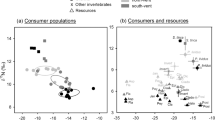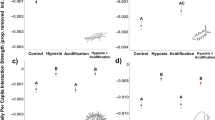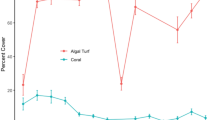Abstract
Ocean warming and acidification affect species populations, but how interactions within communities are affected and how this translates into ecosystem functioning and resilience remain poorly understood. Here we demonstrate that experimental ocean warming and acidification significantly alters the interaction network among porewater nutrients, primary producers, herbivores and burrowing invertebrates in a seafloor sediment community, and is linked to behavioural plasticity in the clam Scrobicularia plana. Warming and acidification induced a shift in the clam’s feeding mode from predominantly suspension feeding under ambient conditions to deposit feeding with cascading effects on nutrient supply to primary producers. Surface-dwelling invertebrates were more tolerant to warming and acidification in the presence of S. plana, most probably due to the stimulatory effect of the clam on their microalgal food resources. This study demonstrates that predictions of population resilience to climate change require consideration of non-lethal effects such as behavioural changes of key species.
This is a preview of subscription content, access via your institution
Access options
Access Nature and 54 other Nature Portfolio journals
Get Nature+, our best-value online-access subscription
$29.99 / 30 days
cancel any time
Subscribe to this journal
Receive 12 print issues and online access
$209.00 per year
only $17.42 per issue
Buy this article
- Purchase on Springer Link
- Instant access to full article PDF
Prices may be subject to local taxes which are calculated during checkout




Similar content being viewed by others
Data availability
The data supporting the findings of this study are available at the Marine Data Archive (mda.vliz.be) via https://doi.org/10.14284/389 or from the corresponding author on reasonable request. Source data for Figs. 1–3 and Extended Data Fig. 1 are provided with the paper.
References
Tuomainen, U. & Candolin, U. Behavioural responses to human-induced environmental change. Biol. Rev. 86, 640–657 (2011).
Zarnetske, P. L., Skelly, D. K. & Urban, M. C. Biotic multipliers of climate change. Science 336, 1516–1518 (2012).
Dupont, S. & Pörtner, H. Get ready for ocean acidification. Nature 489, 429 (2013).
Gilman, S. E., Urban, M. C., Tewksbury, J., Gilchrist, G. W. & Holt, R. D. A framework for community interactions under climate change. Trends Ecol. Evol. 25, 325–331 (2010).
Nagelkerken, I. & Munday, P. L. Animal behaviour shapes the ecological effects of ocean acidification and warming: moving from individual to community-level responses. Glob. Change Biol. 22, 974–989 (2016).
Doney, S. C., Fabry, V. J., Feely, R. A. & Kleypas, J. A. Ocean acidification: the other CO2 problem. Ann. Rev. Mar. Sci. 1, 169–192 (2009).
Harvey, B. P., Gwynn-Jones, D. & Moore, P. J. Meta-analysis reveals complex marine biological responses to the interactive effects of ocean acidification and warming. Ecol. Evol. 3, 1016–1030 (2013).
Belkin, I. M. Rapid warming of large marine ecosystems. Prog. Oceanogr. 81, 207–213 (2009).
Provoost, P., van Heuven, S., Soetaert, K., Laane, R. W. P. M. & Middelburg, J. J. Seasonal and long-term changes in pH in the Dutch coastal zone. Biogeosciences 7, 3869–3878 (2010).
Middelburg, J. J., Soetaert, K. & Herman, P. M. J. Empirical relationships for use in global diagenetic models. Deep-Sea Res. Pt I 44, 327–344 (1997).
Snelgrove, P. V. R. et al. Global carbon cycling on a heterogeneous seafloor. Trends Ecol. Evol. 33, 96–105 (2018).
Schade, H. et al. Simulated leakage of high pCO2 water negatively impacts bivalve dominated infaunal communities from the Western Baltic Sea. Sci. Rep. 6, 31447 (2016).
Alsterberg, C., Eklöf, J. S., Gamfeldt, L., Havenhand, J. N. & Sundbäck, K. Consumers mediate the effects of experimental ocean acidification and warming on primary producers. Proc. Natl Acad. Sci. USA 110, 8603–8608 (2013).
Chennu, A. et al. Effects of bioadvection by Arenicola marina on microphytobenthos in permeable sediments. PLoS ONE 10, e0134236 (2015).
Wanink, J. H. & Zwarts, L. Rate-maximizing optimality models predict when oystercatchers exploit a cohort of the bivalve Scrobicularia plana over a 7-year time span. J. Anim. Ecol. 70, 150–158 (2001).
Clare, D. S., Spencer, M., Robinson, L. A. & Frid, C. L. J. Species densities, biological interactions and benthic ecosystem functioning: an in situ experiment. Mar. Ecol. Prog. Ser. 547, 149–161 (2016).
Hughes, R. N. A study of feeding in Scrobicularia plana. J. Mar. Biol. Assoc. UK 49, 805–823 (1969).
Blackford, J. et al. Detection and impacts of leakage from sub-seafloor deep geological carbon dioxide storage. Nat. Clim. Change 4, 1011–1016 (2014).
Michaelidis, B., Ouzounis, C., Paleras, A. & Portner, H. O. Effects of long-term moderate hypercapnia on acid–base balance and growth rate in marine mussels Mytilus galloprovincialis. Mar. Ecol. Prog. Ser. 293, 109–118 (2005).
Volkenborn, N. & Reise, K. Lugworm exclusion experiment: responses by deposit feeding worms to biogenic habitat transformations. J. Exp. Mar. Biol. Ecol. 330, 169–179 (2006).
Nielsen, O. I., Gribsholt, B., Kristensen, E. & Revsbech, N. P. Microscale distribution of oxygen and nitrate in sediment inhabited by Nereis diversicolor: spatial patterns and estimated reaction rates. Aquat. Microb. Ecol. 34, 23–32 (2004).
Stief, P. Stimulation of microbial nitrogen cycling in aquatic ecosystems by benthic macrofauna: mechanisms and environmental implications. Biogeosciences 10, 7829–7846 (2013).
Volkenborn, N. et al. Intermittent bioirrigation and oxygen dynamics in permeable sediments: an experimental and modeling study of three tellinid bivalves. J. Mar. Res. 70, 794–823 (2012).
Lopez-Urrutia, A., Martin, E. S., Harris, R. P. & Irigoien, X. Scaling the metabolic balance of the oceans. Proc. Natl Acad. Sci. USA 103, 8739–8744 (2006).
Kroeker, K. J. et al. Impacts of ocean acidification on marine organisms: quantifying sensitivities and interaction with warming. Glob. Change Biol. 19, 1884–1896 (2013).
Moens, T. et al. Diatom feeding across trophic guilds in tidal flat nematodes, and the importance of diatom cell size. J. Sea Res. 92, 125–133 (2014).
Beman, J. M. et al. Global declines in oceanic nitrification rates as a consequence of ocean acidification. Proc. Natl Acad. Sci. USA 108, 208–213 (2011).
Braeckman, U. et al. Empirical evidence reveals seasonally dependent reduction in nitrification in coastal sediments subjected to near future ocean acidification. PLoS ONE 9, e108153 (2014).
Thomsen, J., Casties, I., Pansch, C., Körtzinger, A. & Melzner, F. Food availability outweighs ocean acidification effects in juvenile Mytilus edulis: laboratory and field experiments. Glob. Change Biol. 19, 1017–1027 (2013).
Rossoll, D. et al. Ocean acidification-induced food quality deterioration constrains trophic transfer. PLoS ONE 7, e34737 (2012).
Mora, C. et al. Biotic and human vulnerability to projected changes in ocean biogeochemistry over the 21st century. PLoS Biol. 11, e1001682 (2013).
Vargas, C. A. et al. Species-specific responses to ocean acidification should account for local adaptation and adaptive plasticity. Nat. Ecol. Evol. 1, 0084 (2017).
Pierrot, D., Lewis, E. & Wallace, D. W. R. MS Excel Program Developed for CO 2 System Calculations ORNL/CDIAC-105a (Carbon Dioxide Information Analysis Center, 2006).
Zeebe, R. & Wolf-Gladrow, D. CO 2 in Seawater: Equilibrium, Kinetics, Isotopes Vol. 65 (Elsevier, 2001).
Van Heuven, S., Pierrot, D., Rae, J. W. B., Lewis, E. & Wallace, D. W. R. MATLAB Program Developed for CO 2 System Calculations ORNL/CDIAC-105b (Carbon Dioxide Information Analysis Center, 2011).
Wethey, D. S. & Woodin, S. A. Infaunal hydraulics generate porewater pressure signals. Biol. Bull. 209, 139–145 (2005).
Woodin, S. A., Wethey, D. S. & Volkenborn, N. Infaunal hydraulic ecosystem engineers: cast of characters and impacts. Integr. Comp. Biol. 50, 176–187 (2010).
R: A Language and Environment for Statistical Computing (R Foundation for Statistical Computing, 2018).
Van Colen, C. et al. Macrobenthic recovery from hypoxia in an estuarine tidal mudflat. Mar. Ecol. Prog. Ser. 372, 31–42 (2008).
Dickson, A.G. in Guide to Best Practices for Ocean Acidification Research and Data Reporting (eds Riebesell, U. et al.) 17–40 (Publications Office of the European Union, 2011).
Wright, S.W. & Jeffrey, S.W. in Phytoplankton Pigments in Oceanography: Guidelines to Modern Methods (eds Jeffrey, S.W. et al.) 327–341 (UNESCO, 1997).
Campanyà-llovet, N., Snelgrove, P. V. R. & Parrish, C. C. Rethinking the importance of food quality in marine benthic food webs. Prog. Oceanogr. 156, 240–251 (2017).
Rosseel, Y. lavaan: An R package for structural equation modeling and more. R package version 0.3-1 (BETA) (2011).
Michaud, E., Desrosiers, G., Mermillod-Blondin, F., Sundby, B. & Stora, G. The functional group approach to bioturbation: II. the effects of the Macoma balthica community on fluxes of nutrients and dissolved organic carbon across the sediment–water interface. J. Exp. Mar. Biol. Ecol. 337, 178–189 (2006).
Herman, P. M. J., Middelburg, J. J., Widdows, J., Lucas, C. H. & Heip, C. H. R. Stable isotopes as trophic tracers: combining field sampling and manipulative labelling of food resources for macrobenthos. Mar. Ecol. Prog. Ser. 204, 79–92 (2000).
Weerman, E. J. et al. Changes in diatom patch-size distribution and degradation in a spatially self-organized intertidal mudflat ecosystem. Ecol. Soc. Am. 93, 608–618 (2012).
Sahan, E. et al. Community structure and seasonal dynamics of diatom biofilms and associated grazers in intertidal mudflats. Aquat. Microb. Ecol. 47, 253–266 (2007).
Hiddink, J. G., Ter Hofstede, R. & Wolff, W. J. Predation of intertidal infauna on juveniles of the bivalve Macoma balthica. J. Sea Res. 47, 141–159 (2002).
Scaps, P. A review of the biology, ecology and potential use of the common ragworm Hediste diversicolor (O. F. Müller) (Annelida: Polychaeta). Hydrobiologia 470, 203–218 (2002).
Kline, R. B. Principles and Practice of Structural Equation Modeling (Guilford Publications, 2015).
Thrush, S. F. et al. Experimenting with ecosystem interaction networks in search of threshold potentials in real-world marine ecosystems. Ecology 95, 1451–1457 (2014).
Lomas, M. W. & Glibert, P. M. Temperature regulation of nitrate uptake: a novel hypothesis about nitrate uptake and reduction in cool-water diatoms. Limnol. Oceanogr. 44, 556–572 (1999).
Glibert, P. M. et al. Pluses and minuses of ammonium and nitrate uptake and assimilation by phytoplankton and implications for productivity and community composition, with emphasis on nitrogen-enriched conditions. Limnol. Oceanogr. 61, 165–197 (2016).
Norkko, A., Villna, A., Norkko, J., Valanko, S. & Pilditch, C. Size matters: implications of the loss of large individuals for ecosystem function. Sci. Rep. 3, 1–7 (2013).
Bates, D., Mächler, M., Bolker, B. & Walker, S. Fitting linear mixed-effects models using lme4. J. Stat. Softw. 67, 51 (2015).
Kuznetsova, A., Brockhoff, P. B. & Christensen, R. H. B. lmerTest: Tests in linear mixed effects models. R package version 2–0 (2015).
Acknowledgements
The research leading to the results presented in this publication was carried out with infrastructure funded by EMBRC Belgium - FWO project GOH3817N. This work was co-funded by a MARES Joint Doctorate programme grant (2012-1720/001-001-EMJD) to E.Z.O. C.V.C. acknowledges the Research Foundation Flanders (FWO) for his postdoctoral research fellow grant (FWO-11.2.380.11.N.00). Pressure sensor development was funded by grants from the US Office of Naval Research (N00014-0310352) and the US National Science Foundation (OCE 0928002) to S.A.W. and D.S.W. Additional funding for this project was obtained from the Special Research Fund (BOF) from Ghent University through GOA projects 01GA1911W and 01G02617. We acknowledge Flanders Marine Institute (VLIZ) for the total alkalinity measurements.
Author information
Authors and Affiliations
Contributions
C.V.C. and E.Z.O. conceived and carried out the experiments. C.V.C., E.Z.O., M.B., E.A. and S.A.W. analysed the data. C.V.C., M.B., D.S.W., T.M. and S.A.W. contributed materials. C.V.C. and E.Z.O. co-wrote the manuscript. All authors proofread the manuscript, provided input and approved the manuscript.
Corresponding author
Ethics declarations
Competing interests
The authors declare no competing interests.
Additional information
Peer review information Nature Climate Change thanks Paul Snelgrove, Cristian Vargas and the other, anonymous, reviewer(s) for their contribution to the peer review of this work.
Publisher’s note Springer Nature remains neutral with regard to jurisdictional claims in published maps and institutional affiliations.
Supplementary information
Supplementary Information
Supplementary Figs. 1 and 2 and Tables 1–4.
Source data
Source Data Fig. 1
Numerical data.
Source Data Fig. 2
Numerical data.
Source Data Fig. 3
Numerical data.
Source Data Extended Data Fig. 1
Numerical data.
Rights and permissions
About this article
Cite this article
Van Colen, C., Ong, E.Z., Briffa, M. et al. Clam feeding plasticity reduces herbivore vulnerability to ocean warming and acidification. Nat. Clim. Chang. 10, 162–166 (2020). https://doi.org/10.1038/s41558-019-0679-2
Received:
Accepted:
Published:
Issue Date:
DOI: https://doi.org/10.1038/s41558-019-0679-2



